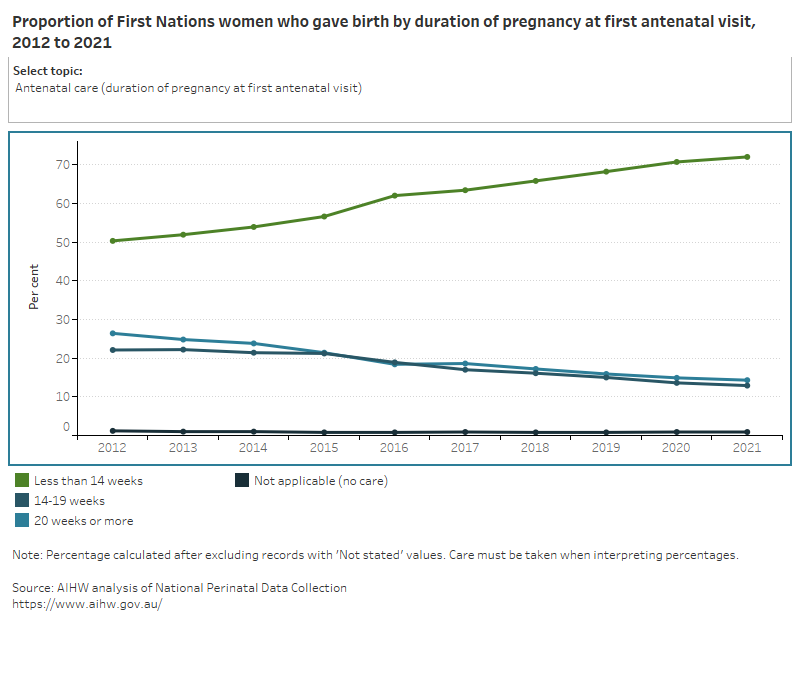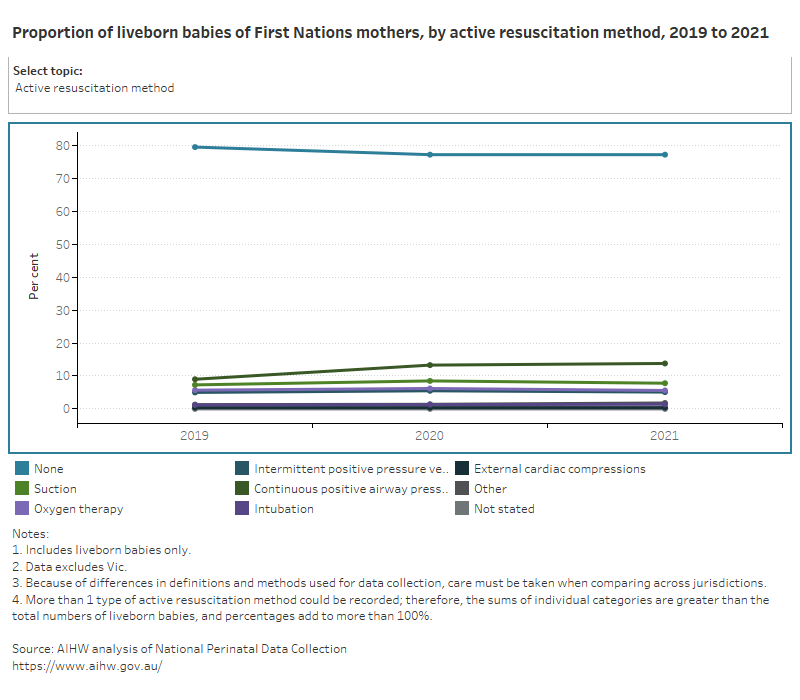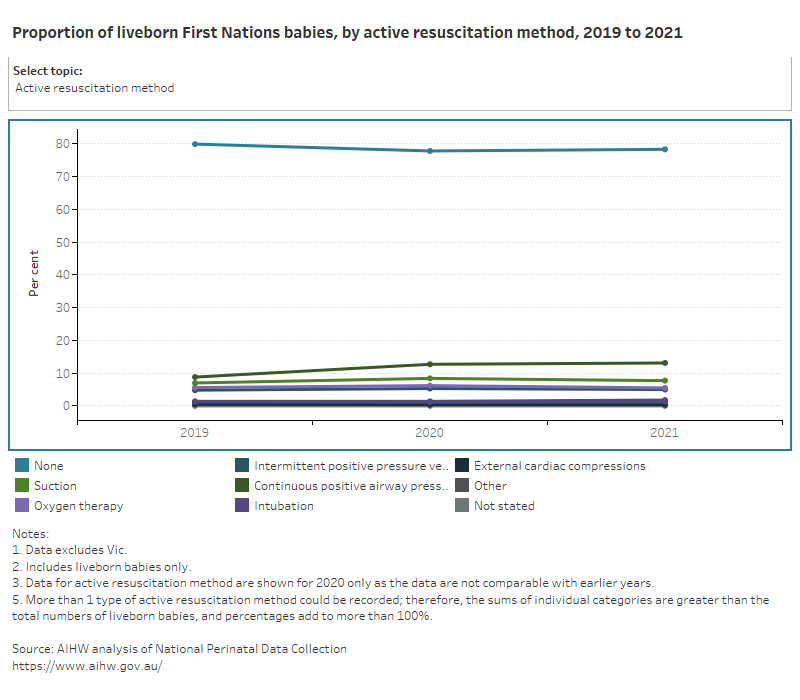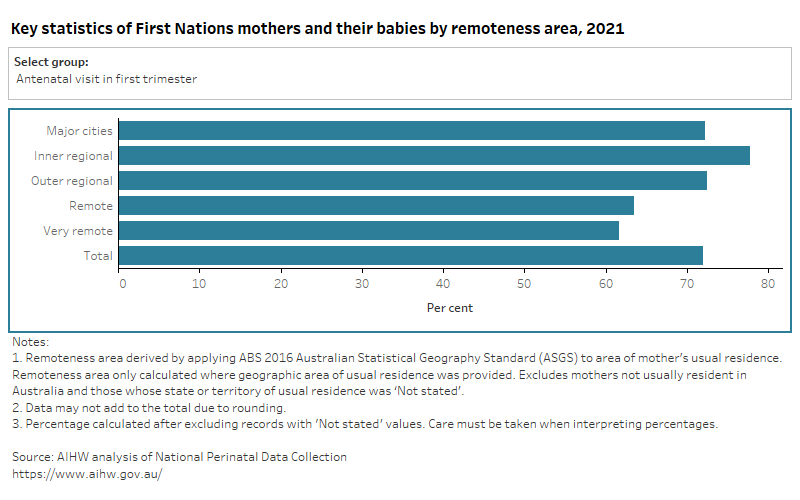First Nations mothers and babies
Although a range of data by First Nations status (those who self-reported as Aboriginal and/or Torres Strait Islander) has been presented in other sections, this section provides more in-depth information on First Nations mothers, babies born to First Nations mothers and First Nations babies.
First Nations mothers
In 2021, First Nations mothers accounted for 5.0% (15,437) of women who gave birth.
Figure 1 presents data for First Nations women who gave birth, by selected maternal characteristics over an 11-year period (where available).
Figure 1: Proportion of First Nations women who gave birth, by selected topic
Line graph of First Nations women who gave birth by selected topics between 2012 and 2021.

There have been improvements in outcomes for First Nations mothers in recent years, with:
- a notable increase in the proportion of First Nations mothers attending an antenatal visit in the first trimester (from 50% in 2012 to 72% in 2021)
- an increase in the proportion of First Nations mothers attending 5 or more antenatal visits (from 85% in 2012 to 88% in 2021)
- a decrease in the proportion of First Nations mothers who reported smoking in the first 20 weeks of pregnancy (from 50% in 2011 to 40% in 2021) and after 20 weeks of pregnancy (from 45% in 2011 to 36% in 2021).
The proportion of First Nations mothers who report smoking at any time during pregnancy has also fallen (from 50% in 2011 to 42% in 2021), and of those who smoked, the rate of smoking cessation during pregnancy was around 1 in 8. This is based on First Nations mothers who reported smoking in the first 20 weeks of pregnancy and not smoking after 20 weeks of pregnancy.
The proportion of First Nations teenage mothers (aged under 20) who gave birth has been gradually decreasing from 19% in 2011 to 10% in 2021.
Around 3 in 5 (60%) First Nations mothers had a non-instrumental vaginal birth, and around 1 in 3 (33%) gave birth by caesarean section. Most First Nations mothers had 5 or more antenatal visits (almost 9 in 10 or 87%).
Babies of First Nations mothers
In 2021, babies born to First Nations mothers accounted for 5.0% (15,689) of all births.
Figure 2 presents data for babies of First Nations mothers, by selected maternal and baby characteristics over an 11-year period (where available).
Figure 2: Proportion of liveborn babies of First Nations mothers, by selected topic
Line graph shows babies of First Nations mother by selected topics between 2019 and 2021.

Most babies of First Nations mothers were born at term (born from 37 to 41 weeks) and with a normal birthweight (86% and 87%, respectively). A high proportion of babies of First Nations mothers had a normal birthweight adjusted for gestational age (77%), with 13% of babies born to First Nations mothers being small for gestational age.
In 2021, 87% of babies of First Nations mothers had a normal birthweight (birthweight between 2,500 and 4,499 grams; also referred to as 'healthy birthweight'). Increasing the proportion of First Nations babies with a healthy birthweight to 91% by 2031, is one of the targets in the National Agreement on Closing the Gap.
Almost all babies of First Nations mothers (97%) had an Apgar score of 7–10 at 5 minutes after birth, indicating that they have adapted well post-birth.
Babies of First Nations mothers most commonly had a hospital stay of 2–3 days (42%), with 30% having a stay of 1 day and 9.7% having a stay of 6 days or more.
First Nations babies
First Nations babies are those whose mother or father (or both parents) are First Nations. In 2021, First Nations babies accounted for 6.1% (19,155) of all births. A high proportion of First Nations babies were born at term (87%) and with a normal birthweight (88%).
The outcomes for First Nations babies and babies of First Nations mothers are very similar. Figure 3 presents data for First Nations babies, by selected maternal and baby characteristics over a 9-year period (where available).
Figure 3: Proportion of liveborn First Nations babies, by selected topic
Line graph of First Nations babies by selected topics between 2019 and 2021.

Remoteness area
Remoteness area can influence several key statistics for First Nations mothers and babies. For example, First Nations mothers who live in Very remote areas are more likely to smoke. These and other statistics can be explored in Figure 4.
Figure 4: Key statistics of First Nations mothers and their babies by remoteness area
Bar chart of First Nations mothers and babies of key statistics by remoteness area in 2021.

It is important to note that despite improvements, First Nations mothers and babies continue to experience poorer health outcomes than non-Indigenous mothers and babies in some areas, and that there are complex interactions between maternal and perinatal health outcomes and the determinants of health, including both social determinants and health risk factors.
For more information on First Nations babies and babies born to First Nations mothers see National Perinatal Data Collection annual update data tables 3.4 and 3.12.


